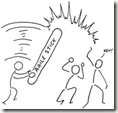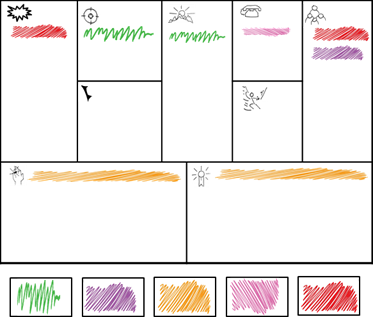Each minimum viable change that is sketched out should tie into one or more of the elements contained in the various sections on the transformation canvas.
Change agents often will be faced with the dilemma of which minimum viable change to execute first.
One way to evaluate the priority of potential minimum viable changes is to evaluate them against Each other from a risk perspective.
Sections of the transformation canvas can be validated in an order suggested by the severity of risk underlying the assumptions contained within That section.
Each minimum viable change can be designed to validate different assumptions and hence mitigate different types of risk on the transformation canvas.
One minimum viable change may be directed at a highly resistant group of change recipients. Another minimum viable change may ask change recipients to adopt skills that do Not really help them perform better in the short term.

Let's look at a number of risks that we could use to prioritize our minimum viable changes. If we imagine a backlog of MVCs color-coded by risk, we can annotate the appropriate section of the transformation canvas and prioritize the backlog based on the severity of that risk.
Resistance to Change

At the beginning of a transformation, resistance to change can be often best dealt with by prioritizing the MVC that targets the group of change recipients on your transformation canvas who are most able to identify with current pinpoints.

Ease of Collaboration and Communication

Ease of collaboration is probably one of your next most important factors to consider when it comes to prioritizing your Minimum Viable Changes.
When starting a transformation, change efforts are better focused in such a way that they allow change recipients and change agents to collaborate with each other and any stakeholders in a highly interpersonal way. When possible try to choose an MVC that allows your change recipients to work in high touch sessions, preferably face-to-face, and prioritize this type of MVC is over ones that require distributed and/or dispersed teams.

Sustainability of Change

A big risk to the sustainability of any agile / Lean Change effort is leadership and executive commitment. Real and deep support is required to make sure that change sticks within the organization. Minimum Viable Changes that have more obvious leadership support our better tackle earlier within a transformation verses one that have less.

Impact of Change

Impact also needs to be considered when prioritizing MVCs, when evaluating the various recipient segments on your transformation canvas, prioritize MVC's that interact with recipients who you believe will have the most impact on realizing transformation vision, in relationship to the time and effort required.

Correctness of Change

Finally prioritize Minimum Viable Changes that are more likely to validate your overall target state, versus other changes that may only validate a single theme or isolated method within your target state. Notice that we have selected this kind of MVC relatively later than ones that mitigate other types of risks. This is intentional, particular element of the target state often end up being "incorrect" not because they are wrong, but because they are not consumable, not provide the right value relating to the efforts required to learn. Our experience is that trying to get a complete target state validated upfront is expensive, and would require a lot of rework.

It should be stated that the risks stated here, and the means of prioritizing different Minimum Viable Changes based on these risks is just a suggested thinking tool. This is not an exhaustive list of risks, nor is it the only way to prioritize activity based on those risks. The point is to be able to look at your transformation canvas and evaluate assumptions on the canvas from a risk perspective, and use that risk perspective to prioritize and evaluate your different MVCs against each other.
Read More Lean Change - Chapter 5: Using a Transformation Canvas for Enterprise Change
No comments:
Post a Comment